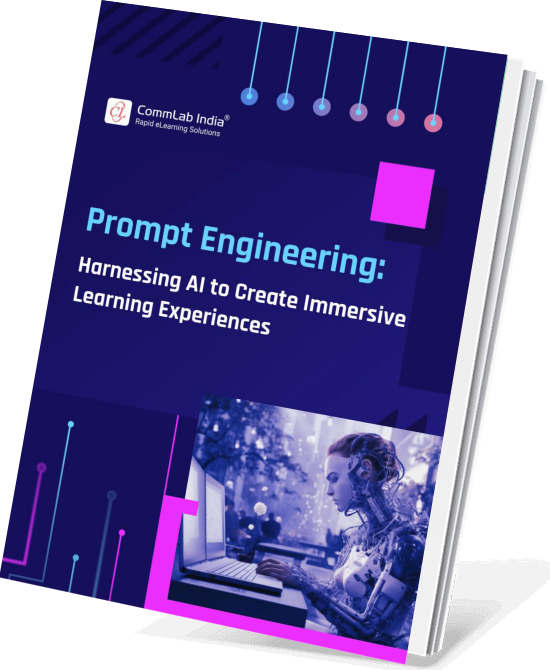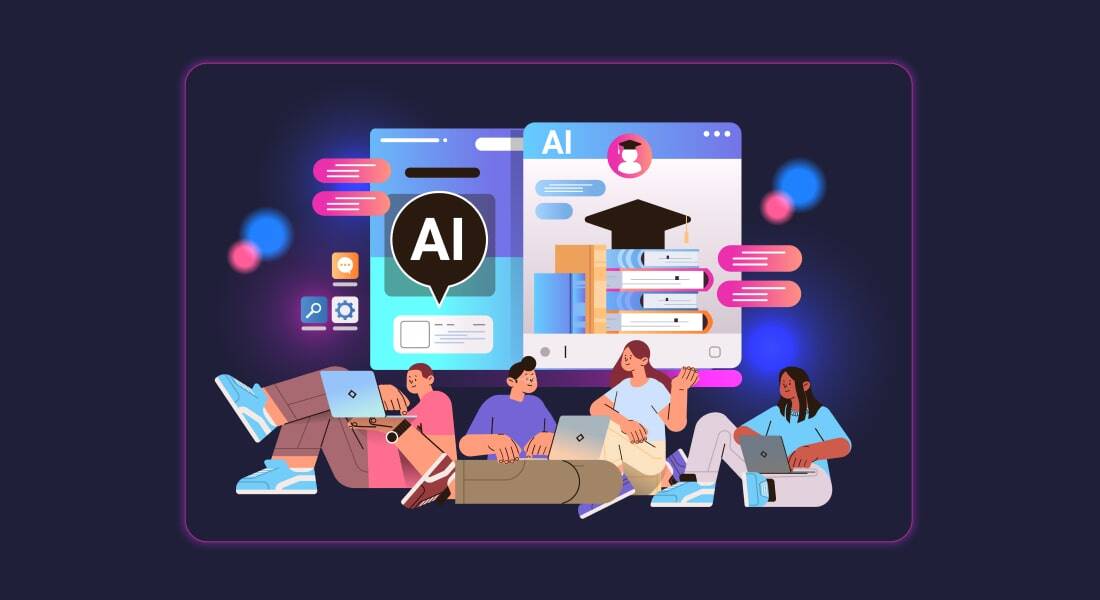Instructional Design Strategies for eLearning [What, Why, & How]
![Instructional Design Strategies for eLearning [What, Why, & How] Instructional Design Strategies for eLearning [What, Why, & How]](https://blog.commlabindia.com/hubfs/blogs/instructional-design-strategy-importance-in-elearning.jpg)
In the dynamic landscape of online training, crafting a compelling eLearning experience requires more than just engaging content—it demands a strategic approach to eLearning design and development. At the heart of this approach lies the field of Instructional Design which focuses on helping instructional designers create structured, engaging, and learner-centric custom eLearning experiences. In this blog, we’ll learn about the importance of instructional design strategies in the world of eLearning and explore how they serve as the linchpin for creating impactful and meaningful eLearning courses for corporate training.
→ Download eBook: Prompt Engineering for Instructional Design
Table of Contents
- What are Instructional Design Strategies?
- What Is the Difference Between Instructional Design Models and Instructional Design Strategies?
- Why Are Instructional Design Strategies Important in eLearning?
- What are the Essential Components of a Robust Instructional Design Strategy?
- Why Is a Good Visual Strategy So Important in eLearning Design?
- What are Some Popular Instructional Design Strategies?
- How to Select the Right Instructional Design Strategy for an eLearning Course?
What Are Instructional Design Strategies?
In the business context, a strategy involves planning and doing what needs to be done to accomplish business goals and making decisions on issues such as resource allocation, business expansion, etc. An instructional design strategy is a high-level approach to how a particular topic will be discussed in the eLearning course. It encompasses the methods, techniques, and devices used to instruct learners. A few of the popular instructional design strategies are microlearning, scenario-based learning, guided learning, learning through exploration and discovery, and simulations.
What Is the Difference Between Instructional Design Models and Instructional Design Strategies?
A discussion on instructional design strategies can never be complete without a word on instructional design models. There is a significant, often confused, and overlooked distinction between the two.
Let’s take a look.

Why Are Instructional Design Strategies Important in eLearning?
Before jumping straight into details, here’s a quick overview.
Wondering About the Importance of Instructional Design Strategies in eLearning?
Here are some points worth mentioning:
- Enhanced learning outcomes
- Improved engagement and retention
- Adaptability to diverse learners
- Efficient resource utilization
- Continuous improvement and adaptation
1. Enhance Learning Outcomes
Instructional design strategies form the bedrock of custom eLearning by tailoring content to meet specific learning objectives. Forbes highlights that interactive content is far more effective at capturing attention compared to static content. By carefully analyzing learner needs and incorporating engaging interactive elements, these strategies create training materials that are both relevant and thoughtfully structured. The result? Enhanced comprehension and significantly improved learning outcomes.
2. Boost Engagement and Retention
In the vast sea of digital distractions, keeping learners engaged is a formidable challenge. Instructional design strategies incorporate interactive elements, multimedia, and varied eLearning assessment methods to captivate learners' attention. By doing so, ID strategies like scenario-based learning, storytelling, etc., promote active participation, fostering better retention of information and concepts.
3. Facilitate Adaptability to Diverse Learners
Individuals have unique learning styles and preferences. Instructional design strategies take this diversity into account, offering a flexible framework that accommodates various learning modalities. Whether catering to visual, auditory, or kinesthetic learners, these strategies ensure that custom eLearning content is accessible and inclusive.

Prompt Engineering — Harnessing AI to Create Immersive Learning Experiences
Learn the Art of Crafting Effective Prompts and Get Desired Outcomes
- What is Prompt Engineering?
- Why is Prompt Engineering Important?
- How to Craft Effective Prompts?
- And More!
4. Support Continuous Improvement and Adaptation
The digital landscape evolves rapidly, necessitating constant adaptation. Instructional design strategies embrace a cyclical approach, incorporating feedback loops, assessment mechanisms, and learning analytics. This iterative process allows designers to gather insights into the effectiveness of their designs, fostering continuous improvement and ensuring that eLearning content remains relevant and impactful over time.
Watch this video to explore how Generative AI can help you enhance eLearning design.
5. Enable Efficient Resource Utilization
Effective instructional design maximizes the utility of resources by aligning content with learning goals. By eliminating unnecessary information and emphasizing key concepts, these strategies streamline the learning process. This not only saves time but also optimizes the use of technology and other resources, enhancing the overall efficiency of eLearning programs.
What are the Essential Components of a Robust Instructional Design Strategy?
Creating an effective instructional design strategy involves carefully integrating several key components to ensure learners receive a comprehensive and engaging training experience. Here are five essential components to consider:
1. Content
Content is the foundation of any instructional design strategy. It should be relevant, accurate, and aligned with the learning objectives. Content must be well-organized, easy to understand, and should cater to the diverse needs of learners. Use a mix of text, examples, case studies, and real-world applications to make the material engaging and relatable.
2. Visuals
Visual elements play a crucial role in enhancing learning. They help break down complex information, making it easier to grasp. Effective visuals include infographics, diagrams, charts, and images that support and reinforce the content. Ensure visuals are high-quality, relevant, and appropriately placed to aid comprehension and retention.

Prompt Engineering — Harnessing AI to Create Immersive Learning Experiences
Learn the Art of Crafting Effective Prompts and Get Desired Outcomes
- What is Prompt Engineering?
- Why is Prompt Engineering Important?
- How to Craft Effective Prompts?
- And More!
3. Media
Incorporating various media formats, such as videos, podcasts, and interactive simulations, can significantly boost learner engagement. Media provides dynamic and immersive ways to present information, cater to different learning styles, and keep learners interested. Use media strategically to complement the content and not distract from it.
4. Assessments
eLearning assessments are vital for measuring learning outcomes and ensuring learners have understood the material. They can range from quizzes and tests to practical eLearning assignments and projects. Assessments should be designed to provide meaningful feedback, identify areas for improvement, and motivate learners to achieve their goals.
5. Technical
The technical aspect of instructional design ensures that the content, visuals, media, and assessments are delivered seamlessly. This includes the selection of an appropriate learning management system (LMS), ensuring accessibility and compatibility across devices, and providing technical support. A well-functioning technical infrastructure is essential for a smooth and effective learning experience.
Integrating these five components thoughtfully alongside core instructional design principles, can create a robust instructional design strategy that enhances learning outcomes and provides a rich, engaging training experience.
As we have already discussed, visual elements play a crucial role in enhancing learning. Let's now explore why a good visual strategy is so important in eLearning design and how it can significantly impact learner engagement and comprehension.
Why Is a Good Visual Strategy So Important in eLearning Design?
As we have already discussed, visual elements play a crucial role in enhancing learning. A well-executed visual strategy goes a long way in delivering high-quality training while also enhancing the aesthetic value of the course, which creates a good impression on the learner. Various types of visuals, such as charts, images, graphs, videos, drawings, illustrations, photographs, and graphics, can be employed effectively. Now, let's delve into how visualization impacts learning.
Positive Impact on Learning
Visualization makes a significant difference in eLearning because it is self-paced, and we are responsible for engaging the learner. Visuals can be used to display information effectively by making it more accessible and understandable.
For instance, consider two options for presenting types of hazards:
Option 1: There are three types of hazards viz. Chemical hazard, Physical hazard, and Biological hazard.
Option 2: There are three types of hazards such as

Option 2 is more appealing and easier to understand, demonstrating how visuals can enhance comprehension. Here's how visualization positively impacts learning:
1. Self-Explanatory Images: Images or pictures that are self-explanatory help learners quickly grasp the concept without lengthy explanations.
2. Complex Information: Visual representation of information aids in the comprehension of complex data by allowing learners to assimilate multiple factors at a glance.

Prompt Engineering — Harnessing AI to Create Immersive Learning Experiences
Learn the Art of Crafting Effective Prompts and Get Desired Outcomes
- What is Prompt Engineering?
- Why is Prompt Engineering Important?
- How to Craft Effective Prompts?
- And More!
Tips for Effective Use of Visuals
1. Align with Course Objectives: Ensure that visuals match the learning objectives of the course.
2. Realistic Visualization: Make visuals realistic to enhance relatability and understanding.
3. Consistent Placement: Use consistent placement of visual elements onscreen to guide the learner and provide a navigational aid.
4. Visual Appeal: Good visuals stay in the learner's mind, helping them retain knowledge by recollecting graphics and images.
5. Sequential Order: Arrange visual elements in a sequence to provide order and continuity, aiding in the learner's comprehension and retention of the course material.
Proper use of visuals helps learners comprehend the subject matter effectively and retain information for a longer time. We hope you find this blog interesting and helpful. Do share your views!
Having established the critical role that visuals play in eLearning, let's now delve into some popular instructional design strategies that can further enhance the online training experience.
What are Some Popular Instructional Design Strategies?
1. Guided Learning
A guided learning strategy uses characters or avatars to accompany learners throughout the digital course. Such characters act as visual aids and guide learners through the course, allowing them to take their own decisions and make their own choices. This personalized instruction helps establish a connection with your learners, enhance motivation, participation, and knowledge retention. You can use this learning to help new hires find their way through the initial training or convey topics that require a personal touch such as sales training and performance management training.
2. Scenario-based Learning
Scenario-based learning puts employees in relatable situations where they learn by doing tasks or making choices. The situations usually recreate actual issues employees face in their daily work. The context of the scenario such as the setting, characters, and issues encountered play a crucial role in bringing this strategy to life. Learning through scenarios helps build critical-thinking skills, and gain practical knowledge that can be applied directly on the job. This strategy can be used to conduct compliance training or safety training wherein learners have to analyze situations and take appropriate actions. For e.g., you can create a complete scenario where your compliance policies come in play.
Unlock the secrets of Scenario-based learning! Watch now to see how real-life contexts can transform and supercharge your custom eLearning.
3. Case Studies
A case study offers a setting and a context to your employees and helps them immediately apply the knowledge gained. Learners obtain the desired results by making decisions, analyzing problems, and improving conditions. A case study can either be fictitious or based on real incidents and span the entire course. You can form an assessment around the case study and test the learners for the knowledge gained. This strategy is useful for topics where learners need to take decisions or select a course of action from several available ones, like in process training or leadership training.
4. Game-based Learning
Game-based learning involves the use of games and gaming elements to facilitate effective knowledge transfer, build an emotional connection, elicit responses from learners, foster a sense of competition, and help retain knowledge longer. The best thing is that it aims to do all of this while the learners have some fun. Both content and assessments can be gamified in e-learning using game elements such as points, levels, scores, and leaderboards. This instructional design strategy can ensure high impact learning delivery and make competition a big motivator in the learning process. Be it product training, software training, or safety procedures, game-based content can add life to everything.

Watch our game-based learning sample course in action!
5. Simulations
Simulations emulate the actual system and provide learners a safe environment for them to practice without any repercussions. This strategy is used to help learners become familiar with new software, complicated and heavy machinery, and complex products they need to handle in real life. Since learners get to try out the system in a safe environment, it builds their confidence, equips them with on-the-job knowledge and reduces costly errors in real life. Simulations are best used for ERP software training, product training and safety training.
How to Select the Right Instructional Design Strategy for an eLearning Course?
Check out this infographic to learn how to select the most suitable instructional design strategy for your eLearning course.
Wrapping Up!
In the ever-evolving world of online training, crafting an impactful eLearning experience extends beyond engaging content—it demands a strategic approach to design and development. Instructional design serves as the backbone of this approach, focusing on creating structured, engaging, and learner-centric courses. As explored in this blog, effective instructional design strategies are vital in enhancing learning outcomes, boosting engagement, and facilitating adaptability to diverse learners.
By incorporating essential components such as relevant content, compelling visuals, varied media, insightful assessments, and robust technical infrastructure, instructional designers can craft eLearning experiences that are not only effective but also memorable. Visual strategies, in particular, play a crucial role in making complex information more accessible and engaging.
As we transition into discussing popular instructional design strategies, it's clear that choosing the right approach can significantly impact the success of your custom eLearning course. Whether it’s guided learning, scenario-based learning, or game-based learning, each strategy offers unique benefits that cater to different learning needs and goals.
We hope this blog has provided valuable insights into the importance of instructional design and how to effectively implement these strategies. Share your thoughts and experiences, and explore more through our resources to continue enhancing your eLearning initiatives.
In today's AI-driven landscape, instructional design is evolving rapidly. Prompt engineering is at the forefront of this transformation, offering new ways to create immersive and engaging custom eLearning experiences. Discover how to leverage AI with our comprehensive eBook on prompt engineering. Learn the art of crafting effective prompts and stay ahead in the world of eLearning innovation. Download now and transform your design strategies!









